
German postcard by Verlag Hermann Leiser, Berlin-Wilm., no. 2015. Erich Kaiser-Titz in Fürst Seppl/Prince Seppl (Carl Froehlich, 1915).
Erich Kaiser-Titz (1875-1928) was an actor in the German silent cinema of the 1910s and 1920s, playing in almost 300 films.
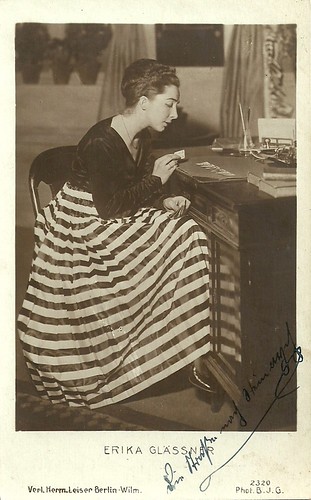
German postcard by Verlag Hermann Leiser, Berlin, no. 2320. Photo: B.J.G. 1910s.
Cute actress Erika Glässner (1890-1959) starred as a backfisch and later as a cheeky temptress in many German films of the silent era. From 1915 till 1952 she appeared in some 80 films.
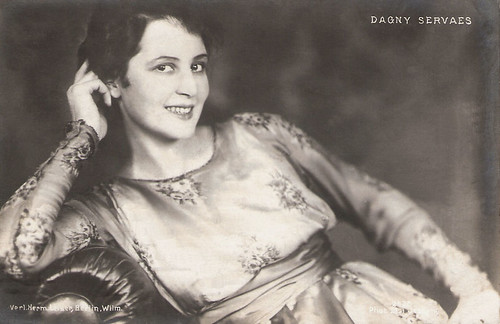
German postcard by Hermann Leiser, Berlin, no. 2429. Photo: Lisi Jessen. Sent by mail in 1918.
Dagny Servaes (1894-1961) was a German-Austrian theatre and film actress. She reached her peak in Ernst Lubitsch Das Weib des Pharao/The Pharao's Wife (1921).
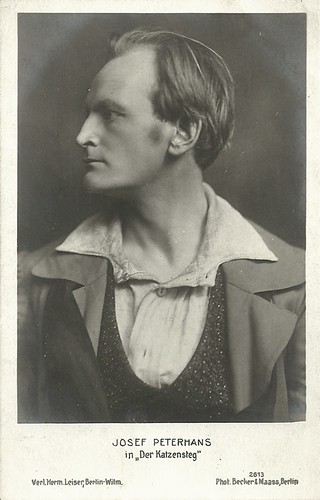
German postcard by Verlag Hermann Leiser, Berlin-Wilm., no. 2613. Photo: Becker & Maass, Berlin. Josef Peterhans in the stage play 'Der Katzensteg', which was based on the eponymous novel (1889) by Hermann Sudermann. The play was adapted into a film, first in 1915 by Max Mack.
Josef Thomas Peterhans (1882-1960) was a German stage and screen actor who peaked in German silent cinema in the late 1910s.
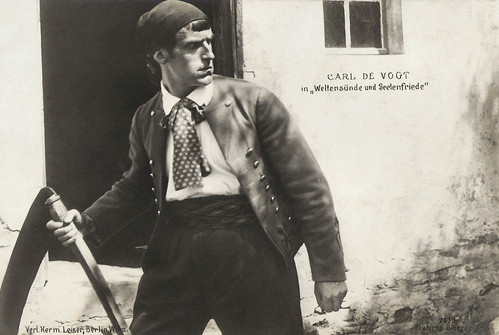
German postcard by Verlag Hermann Leiser, Berlin-Wilm., no. 2639. Photo: Deutsche Bioscop. Carl de Vogt in Weltensünde und Seelenfriede. The title is unknown in our sources.
German actor Carl de Vogt (1885-1970) was a kind of Indiana Jones in the silent films of Fritz Lang. De Vogt was also a popular singer and made several records in the 1920s.
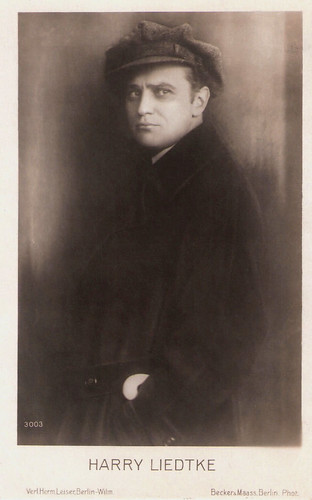
German postcard by Verlag Hermann Leiser, Berlin-Wilm., no. 3003. Photo: Becker & Maass, Berlin.
German actor Harry Liedtke (1882-1945) was the charming ladykiller of many early silent classics. Detective serials like Joe Deebs made him one of the first male stars of the German cinema.
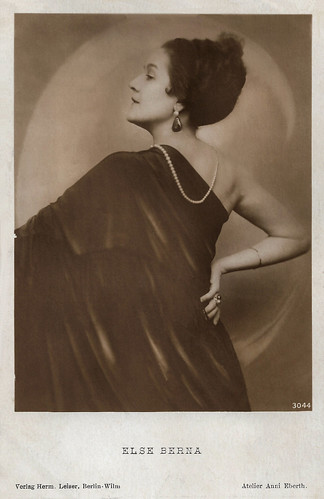
German postcard by Verlag Herm. Leiser, Berlin-Wilm., no. 3044. Photo: Atelier Anni Eberth.
Actress and singer Else Berna appeared in 13 silent German films between 1917 and 1924.
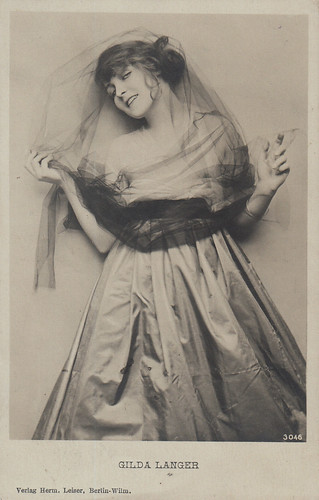
German postcard by Verlag Herm. Leiser, Berlin-Wilm., no. 3046. Collection: Marlene Pilaete.
Gilda Langer (1896-1920) was a German stage and film actress whose career began in the mid-1910s and lasted until her death in 1920. She appeared both on stage and in silent films; however, all films featuring Langer as an actress are now considered lost.

German postcard by Verlag Herm. Leiser, Berlin-Wilm., no. 3047.
Danish silent film actress Asta Nielsen (1881-1972), was one of the most popular leading ladies of the 1910s and one of the first international film stars. Of her 74 films between 1910 and 1932, seventy were made in Germany where she was known simply as Die Asta. Noted for her large dark eyes, mask-like face and boyish figure, Nielsen most often portrayed strong-willed passionate women trapped by tragic consequences.
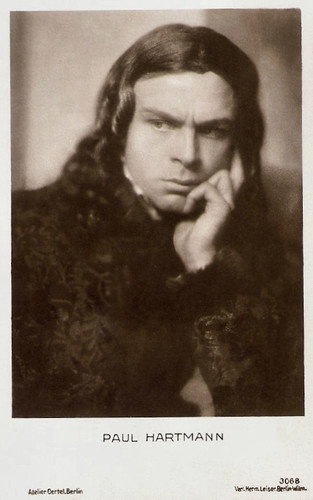
German postcard by Verl. Herm. Leiser, Berlin-Wilm., no. 3068. Photo: Atelier Oertel, Berlin.
German stage actor Paul Hartmann (1889-1977) made over 100 films, both in the silent and the sound period. Despite his commitment to the Nazi regime, he could continue his career quite smoothly into the 1950s and 1960s.
Cataloging the Leiser cards
Jean Ritsema describes at Ross Postcards that cataloguing the Leiser cards was not a straightforward process. It is complicated by the reuse of the inventory control numbers on the cards, as evidenced by the frequent replication of numbers in the catalogue. Through the years, Leiser regularly switched between cards with a full photo format and those with a white-bordered format and the publisher was also not consistent in the card format.
To help untangle the puzzle of the numbering system, Jean listed likely dates for each 1000 group of cards at the top of each group. However, these dates are estimates only and are subject to error. In addition, where known, dates and sources associated with cards have been added as a notation under the catalogue listing.
Probably three or four separate runs of the numbering sequence were used over the years, with cards released in the early years exclusively issued in full photo format. In later years, portrait cards were issued with a white border while film scene cards were issued in full photo format. Whether the full number range (1-9999) was reused in each iteration, or whether only smaller sections of the range were reused, is still unclear.
In the earlier years, Leiser focused on opera and stage performers. During the First World War, the German government stimulated the film industry and decided to promote film stars. From then on the main focus of the Leiser postcards was on film actors. However, musicians, dancers and other social figures appear throughout the whole period. Another factor that complicates cataloguing is the repeated use of the same photo under different inventory numbers.
More complications: some cards were issued in both black-and-white and sepia; several were issued in the standard size as well as a slightly smaller size; cards were reissued with several font variations; and cards were issued both with the text 'Verlag Herm. Leiser' spelt out and with an HLB logo. A final issue that Jean noted was the appearance of a second publisher's mark on several cards, such as for Photochemie and Rotophot. It is unknown if Leiser printed any of the cards he published.
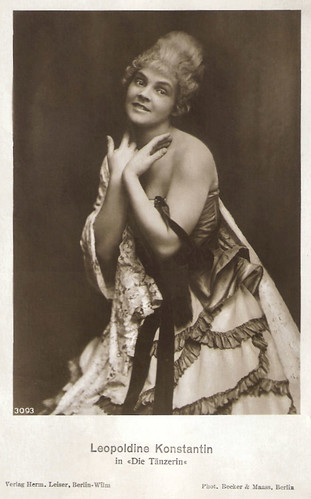
German postcard by Verlag Hermann Leiser, Berlin-Wilm., no. 3095. Photo: Becker & Maas, Berlin. Leopoldine Konstantin in Die Tänzerin/The Dancer (Georg Jacoby, 1915).
Leopoldine Konstantin (1886-1965) was a famous Austrian theatre and film character actress, who worked for years with director Max Reinhardt. She played Claude Rains' dominant mother in Alfred Hitchcock’s classic Notorious (1946). It was her sole Hollywood role.
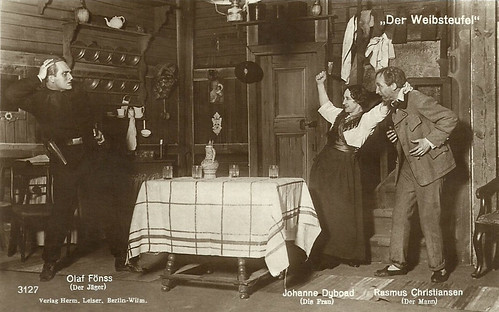
German postcard by Verlag Hermann Leiser, Berlin, no. 3127. Olaf Fønss, Johanne Dybwad and Rasmus Christiansen in the Danish stage production 'Graensejaegeren' (1916-1917), based on the German play 'Der Weibsteufel' (1914) by Karl Schönherr.
Olaf Fønss (1882-1949) was one of Denmark and Germany's biggest stars of the silent film era. He also worked as a film director, producer and censor.
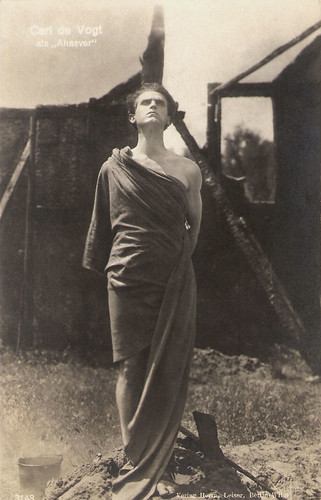
German postcard by Verlag Hermann Leiser, Berlin, no. 3143. Carl de Vogt in Ahasver (Robert Reinert, 1917). Ahasver is a three-part film on the story of the Wandering Jew Ahasver (De Vogt), who is condemned to bring misfortune.
German actor Carl de Vogt (1885-1970) was a kind of Indiana Jones in the silent films of Fritz Lang. De Vogt was also a popular singer and made several records in the 1920s.
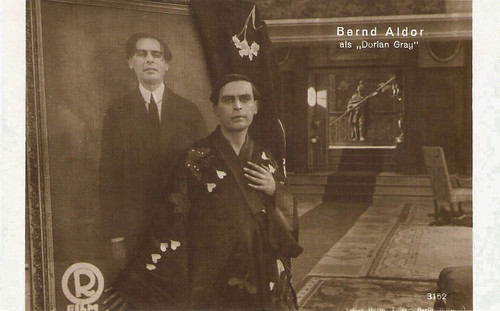
German postcard by Hermann Leiser Verlag, Berlin, no. 3152. Photo: Richard-Oswald-Produktion. Bernd Aldor in Das Bildnis des Dorian Gray/The Picture of Dorian Gray (Richard Oswald, 1917).
Bernd Aldor (1881-1950) was a star of the German silent cinema in the 1910s and 1920s, often in films by Richard Oswald or Lupu Pick. Sound film and the Nazi regime broke the career of this Jewish actor.
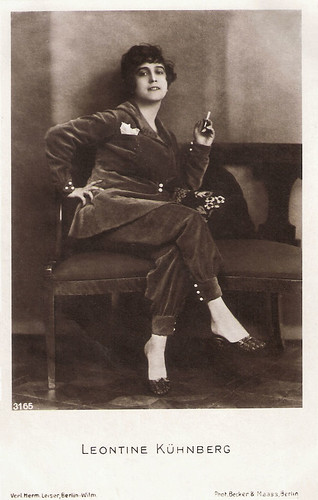
German postcard by Verlag Hermann Leiser, Berlin-Wilm., no. 3165. Photo: Becker & Maass, Berlin.
Leontine Kühnberg (1889-1945?) was a German theatre and silent film actress. For a time she belonged to the ensemble of Max Reinhardt's Deutsches Theater. Shortly before the outbreak of the First World War, she began to make films. In 1921 she married and withdrew from the film sets. She was Jewish and probably died at the end of WW II.
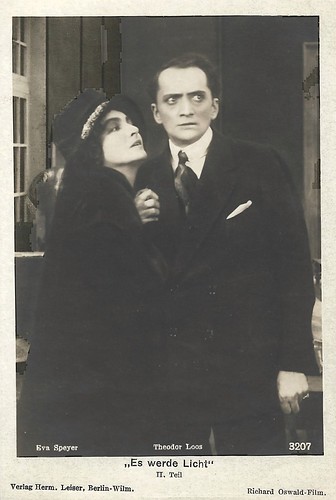
German postcard by Verlag Hermann Leiser, Berlin-Wilm., no. 3207. Photo: Richard Oswald-Film. Theodor Loos and Eva Speyer in Es werde Licht, Teil II (Richard Oswald, 1918).
Theodor Loos (1883-1954) was a German stage and screen actor between the 1910s and the 1950s. He became famous for his parts in Fritz Lang’s German films.
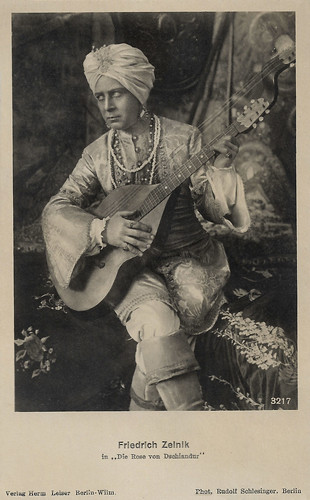
German postcard by Verlag Hermann Leiser, Berlin-Wilm., no. 3217. Photo: Rudolf Schlesinger, Berlin / Berliner Film-Manufaktur. Friedrich Zelnik in Die Rose von Dschiandur/The Rose of Dschiandur (Alfred Halm, 1918).
Austrian actor Friedrich Zelnik or Frederic Zelnik (1885-1950) was also one of the most important producers-directors of the German silent cinema. Already in the early 1910s, he became a film star in Germany, but during the 1920s he had his greatest successes there as director-producer of operetta-style costume films starring his wife, Lya Mara. A critical success was his drama Die Weber/The Weaver (1927). After 1933, he worked in Great Britain and also directed two films in the Netherlands.
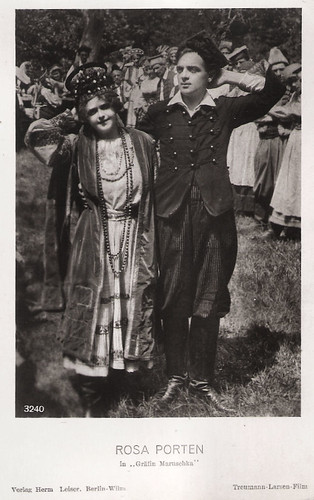
German postcard by Herm. Leiser, Berlin-Wilm., no 3240. Photo: Treumann-Larsen-Film. Rosa Porten and Max Wogritsch in Gräfin Maruschka/Countess Maruschka (Franz Eckstein, Rosa Porten, 1917).
Rosa Porten (1884-1972) was the elder and lesser-known sister of German silent film star Henny Porten. Both sisters started in 1906 as an actress for the pioneering Messter company and Rosa became one of the first women in Germany to write and direct films.

German postcard by Verlag Hermann Leiser, Berlin, no. 3254. Photo: Alba-Film. Stella Harf and Bruno Kastner in Die Fürstin von Beranien (Ernst Reicher, 1918).
German actor Bruno Kastner (1890-1932) was one of the most beloved stars of the 1910s and 1920s. His parts as the elegant and charming dandy made him a heartthrob of the German silent cinema.
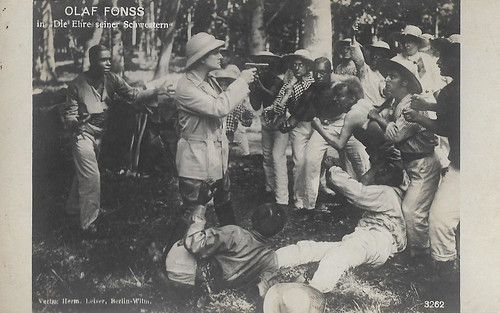
German postcard by Verlag Hermann Leiser, Berlin-Wilm., no. 3262. Olaf Fönss in the Danish flm Gengaeldelsens Ret (Fritz Magnussen 1917). The German title Die Ehre seiner Schwestern on the postcard translates to The Honour of his Sister, and the Danish title means The Right of Retribution.
After having played in Danish films in the early and mid-1910s, Danish actor Olaf Fönss / Olaf Fønss (1882-1949) tried his luck in Germany in 1915. He immediately became the protagonist of the serial Homunculus, written by Robert Reinert, directed by Otto Rippert and released in 1916, with enormous success.
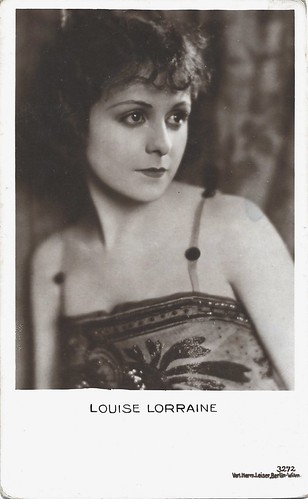
German postcard by Verlag Hermann Leiser, Bwerlin-Wilm., no. 3272.
Louise Lorraine (1904-1981) was an American film actress, who started out in two-reel comedies for independent studios, then spent time at MGM and Universal. She became very popular in action-filled silent serials and may be best remembered for being the third actress to portray Jane, in the serial The Adventures of Tarzan (1921). In 1930, she retired from the film industry.

German postcard by Verlag Hermann Leiser, Berlin-Wilm., no. 3276. Photo: Unfilman.
Priscilla Dean (1896-1987) was an American actress on the silent screen. Between 1912 and 1928, she appeared in some 70 silent films, and later in five sound films. She is best known for her Universal films under the direction of horror specialist Tod Browning.

German postcard by Verl. Herm. Leiser, Berlin-Wilm., no. 3490.
Dutch actor Ernst Winar (1894-1978) appeared in 34 films between 1916 and 1955, in The Netherlands and as well in Germany. He was also a film director and made 14 films between 1922 and 1955. Later he edited the first short films of Dutch director Paul Verhoeven.
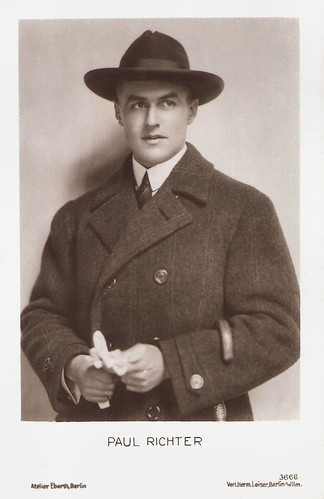
German postcard by Verl. Herm.Leiser, Berlin-Wilm., no. 3666. Photo: Atelier Eberth, Berlin.
Austrian actor Paul Richter (1895-1961) is best known as Siegfried, the hero of the classic fantasy film Die Nibelungen (1924), one of the masterpieces of the German silent cinema, directed by Fritz Lang.
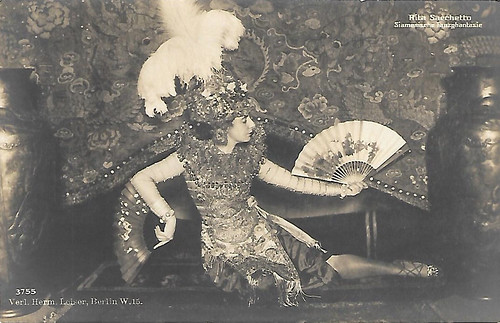
German Postcard by Verlag Hermann Leiser, Berlin, no. 3755. Photo: Rita Sacchetto in the stage performance 'Siamesische Tanzphantasie'. Collection: Didier Hanson.
German actress and dancer Rita Sacchetto (1879-1959) was in the 1910s a star of the Danish Nordisk Film Company.

German postcard by Verlag Hermann Leiser, Berlin-Wilm., no. 3926. Photo: Atelier Oertel, Berlin.
Wilhelm Dieterle (William Dieterle) (1893-1972) was a German actor and director who started out in Weimar cinema, before becoming a well-known Hollywood director.
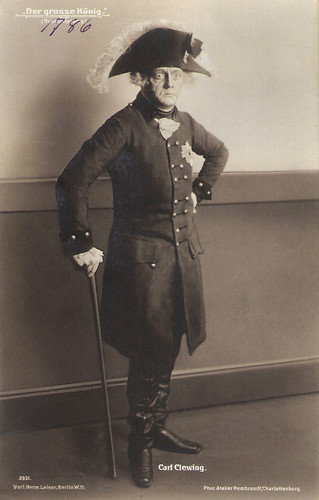
German postcard by Verlag Hermann Leiser, Berlin-Wilm., no. 3931. Photo: Atelier Rembrandt, Charlottenburg. Publicity still for a stage production of Der grosse König (The Great King).
German actor Carl Clewing (1884-1954) was an opera singer, the composer of the song 'Alle Tage ist kein Sonntag' (Not every day is a Sunday) and a Music professor in Berlin. During the years of the early cinema he was much in demand as a film actor.
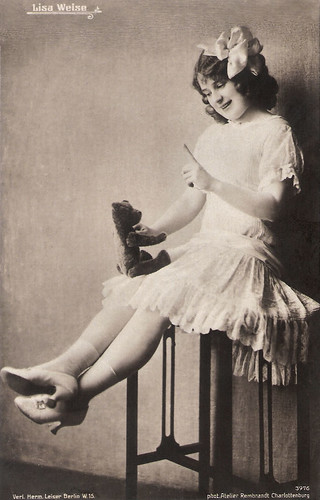
German postcard by Verlag Hermann Leiser, Berlin Wilm., no. 3976. Photo: Rembrandt, Charlottenburg.
German actress Lisa Weise (?-1952) starred in silent films of the 1910s. Most of her films were directed by Friedrich Zelnik and often her film partner was Karl Beckersachs.
To be continued tomorrow!
Source: Jean Ritsema (Ross Postcards).
No comments:
Post a Comment